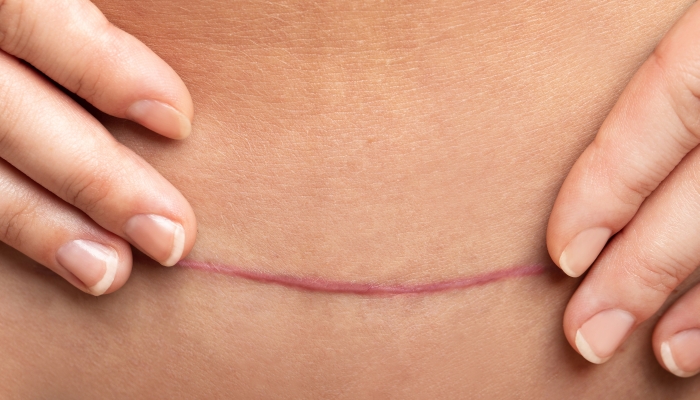Do You Need to Check Your Cervix During Pregnancy?

- A cervical check involves your doctor inserting a gloved finger into your vaginal canal to assess your cervix for changes that happen prior to labor.
- While they are not required procedures, cervical checks can provide helpful information to both you and your doctor leading up to the birth of your baby.
- Be sure to discuss the risk factors and benefits of cervical checks with your doctor so that you know what to expect.
- Cervical exams are typically done in pregnancy to assess for labor, but your provider also might do one in early pregnancy to perform a pap smear as a cervical cancer screening tool.
Congratulations, mama! You’ve made it to the final month of pregnancy and the final countdown to your due date is on. If you’re not scheduling an induction or C-section, how will you know when your baby is coming?
While there’s no crystal ball that will reveal when you’ll get to meet your baby, there are physical changes in your body that can be measured to give us a better idea of how close you are to going into labor. These physical changes can be assessed with a cervical exam.
Also known as pelvic exams or vaginal exams, cervical exams have gotten a bad rap in recent years. The most important thing to know–and what many women don’t understand–is that they are entirely optional.
If your doctor wants to perform a cervical exam, make sure you agree on the rationale behind doing so. There are both risks and benefits to consider with elective cervix checks and it’s important that you have the information you need to make an informed decision.
Where Is the Cervix Located?
The cervix is the narrow opening at the bottom of the uterus that connects the uterus to the vagina and forms the birth canal through which your baby will pass during vaginal birth.
Throughout most of pregnancy, the cervix is closed, but once labor starts it begins to dilate, or open. The cervix also softens and becomes effaced, meaning it stretches and thins in preparation for the baby to pass through the birth canal.
How Is a Cervix Check Done?
During a cervical exam, your doctor will ask you to undress from the waist down and lie on the exam table with your legs elevated in stirrups. Using water-based lubricant and wearing sterile gloves, they will insert their index and middle finger about three to five inches into your vagina until they reach your cervix.
Cervix checks are typically quick and last less than a minute. Afterward, your doctor will give you tissues and a feminine pad to clean up with.

Why are Cervix Checks Performed?
It is a common misconception that a cervical exam is a required routine procedure leading up to giving birth. While some doctors offer to perform cervix checks routinely after 36 weeks, many will only do so under certain circumstances.
As the birth of your baby nears, your cervix changes in preparation for labor. More and more, many obstetric providers are recommending cervix checks based on whether or not the exam will change the way they manage your prenatal care. For example, a cervical exam is completely unnecessary if you have a scheduled Cesarean section and are not having contractions.
That said, there are times when your healthcare provider has a medical reason to check your cervix:
- If you have symptoms of labor, your doctor will want to assess what phase you are in and they will need to do so with a pelvic exam. Signs of labor include regular contractions, cramping, back pain, bleeding, loss of the mucus plug, and amniotic fluid leakage (otherwise known as your water breaking).
- If you are scheduled for a medical induction, elective or otherwise, your doctor will want to know your Bishop Score prior to your induction date. The Bishop Score is a tool that uses specific criteria to predict whether or not a medical induction of labor will be successful. Components of the score include cervical dilation, effacement, consistency, and position, as well as your baby’s station or position. A cervical exam is necessary to determine these factors.
What Is the Meaning of Cervical Dilation and Effacement?
Cervical effacement is the thinning and softening of your cervix. When labor is close, the cervix changes in consistency as it gets thinner. During contractions, your baby’s head will put pressure on the bottom of the uterus, causing it to thin and soften.
Cervical dilation refers to the widening of the cervical opening. During the first stage of labor, the cervix will dilate from zero to ten centimeters. Your cervix is “complete” when it is ten centimeters, or just shy of four inches–think the diameter of a drink coaster or a bagel. This opening allows for your baby’s head to pass through. Hard to believe, right?!
How are Cervical Dilation and Effacement Measured?
Cervical dilation is measured in centimeters. To estimate how many centimeters dilated your cervix is, your care provider assumes each fingertip to be one centimeter. If your care provider is able to insert one fingertip into your cervical opening, your cervix is considered one centimeter dilated (two fingertips equal two centimeters dilated, and so on).
Cervical effacement is measured in percentage. During labor, your cervix will go from 0% to 100% effaced. Normally, your cervix is 0% effaced and is the consistency of the tip of your nose. When it has completely thinned out and 100% effaced, it feels more like the consistency of the inside of your cheek.
It’s important to know that the measurement of cervical dilation and effacement are somewhat subjective based on your care provider. Because cervical checks are done by feel, you can expect a slight variation from person to person.
Benefits of Cervix Checks During Pregnancy
Cervix checks are valuable because they allow your care team to know whether you are in labor and, if so, what phase of labor you are in. They are simple and quick procedures that can be done after 36 weeks of pregnancy at your doctor’s office if desired.
Once you are admitted to the hospital for labor, your nurse or doctor will likely want to perform cervix checks every so often to monitor your labor progress. The first stage of labor, otherwise known as early labor, is split up into three phases, determined by how dilated the cervix is:
- Late labor phase (zero to five centimeters)
- Active labor phase (six to seven centimeters)
- Transition phase (eight to ten centimeters)
Ten centimeters dilation is considered a “complete” cervix. Once your cervix is complete, your body transitions from the first stage of labor to the second stage of labor, known as the pushing stage.
You can see why knowing what’s going on with your cervix at this point of labor is helpful. This is especially true if you’re opting for an epidural, as your body may not have the natural urge to push like it would if you were going through labor unmedicated.
Opting for a home birth? You and your midwife, doula, or other birthing support person will decide whether or not to do cervical exams to check your cervix.

Risks of Cervix Checks During Pregnancy
While generally considered very safe, cervix checks are not without risk.
The most common risk associated with cervical exams is infection. Even a carefully done cervical exam using sterile gloves can increase the risk of infection because bacteria from your vulva and vagina are being pushed up toward your cervix.
Another factor to consider when deciding whether you’d like a cervical exam is false reassurance. Unfortunately, on their own, cervical checks can’t tell us the exact timing of labor or birth. While one woman might walk around with a dilated cervix for days or weeks, another woman could have a completely closed cervix one day and give birth the next.
Wouldn’t it be nice if we had a crystal ball that could predict precisely when labor will start? If only!
FAQs
Are cervical exams painful?
Some women find cervical exams to be quite uncomfortable while others would say they are very tolerable and no big deal. The good news is that care providers who perform cervical exams are trained to move very gently and slowly to not cause any internal cuts or trauma.
If you decide to get an epidural during labor, an added perk is that you won’t feel cervical checks once the epidural is in place.
Can I check my own cervix?
In the final weeks of pregnancy, some women choose to perform a self-exam to see whether their cervix has started to change in preparation for labor. If you are interested in doing this, be sure to discuss how to do so safely and effectively with your care provider. If they give you the green light, use the following steps:
- Clean your hands thoroughly to avoid vaginal infection.
- Remove rings or other jewelry and make sure your nails are trimmed to avoid internal cuts of your vaginal walls.
- Elevate one leg on a surface such as a toilet or stool.
- With one leg elevated and one on the floor, insert two fingers into your vagina as far as you are able until you feel your cervix. While your vaginal walls will feel soft and smooth, your cervix will feel firmer.
Can I assess for cervical changes without an exam?
Some women find cervical exams to be too painful or invasive. In this case, you might choose to use the “red/purple line method” used by many doulas as a risk-free and non-invasive alternative to a traditional pelvic exam.
This method involves having your birthing support person look at your natal cleft (otherwise known as your butt crack) to see if it’s developing a reddish or purple line. The idea is that the further up toward your back the line appears, the more dilated and ripe your cervix is. While the science behind this trick isn’t conclusive, there’s no downside to checking!
What is a membrane sweep?
Sometimes called membrane stripping, a membrane sweep is done as an attempt to induce labor in late pregnancy. During a cervical exam, your doctor will use their fingers to try to separate your amniotic sac from the inside of your uterus. While not guaranteed, membrane sweeping can trigger the release of prostaglandins, which are hormone-like substances that help your cervix progress in labor.
Some women opt for this method over using Pitocin or other medication to induce labor. It’s worth noting that your cervix has to have begun to dilate for your provider to reach his fingers into the cervix to separate the membrane.
What other times might my doctor check my cervix?
Most cervical checks occur in the last few weeks of pregnancy leading up to your due date and are used to assess for effacement and to determine dilation. Sometimes in early pregnancy, it is also necessary for your doctor to do an internal exam and perform a cervical check in the form of a pap smear for cervical cancer screening.
Some doctors will perform a pap smear during your very first prenatal visit. Pap smears serve as a screening for cervical cancer or pre-cancer and look for atypical cells on the cervix.
A pap smear is done similarly to a cervical exam, but instead of using a gloved hand, your provider inserts a thin brush into your vagina and uses it to collect cervical cells. While a pap smear might feel uncomfortable, it shouldn’t be painful.

The information WonderBaby provides is not intended to be, and does not constitute, medical or other health advice or diagnosis and should not be used as such. Always consult with a qualified medical professional about your specific circumstances.
Related Posts

Pregnancy
How To Deal With an Ingrown Hair on a C-Section Scar
Ingrown hairs on a C-section scar can be treated using a warm compress or mild exfoliation. Infected ingrown hairs may require antibiotic treatment.

Pregnancy
What’s a Dye Stealer Pregnancy Test?
A dye stealer pregnancy test usually means that your hCG levels are very high, which is typically considered a good sign for pregnancy.

Pregnancy
Can Yelling Cause a Miscarriage?
Yelling alone can not cause a miscarriage. However, maternal stress can cause high blood pressure, preterm labor, and other health problems.